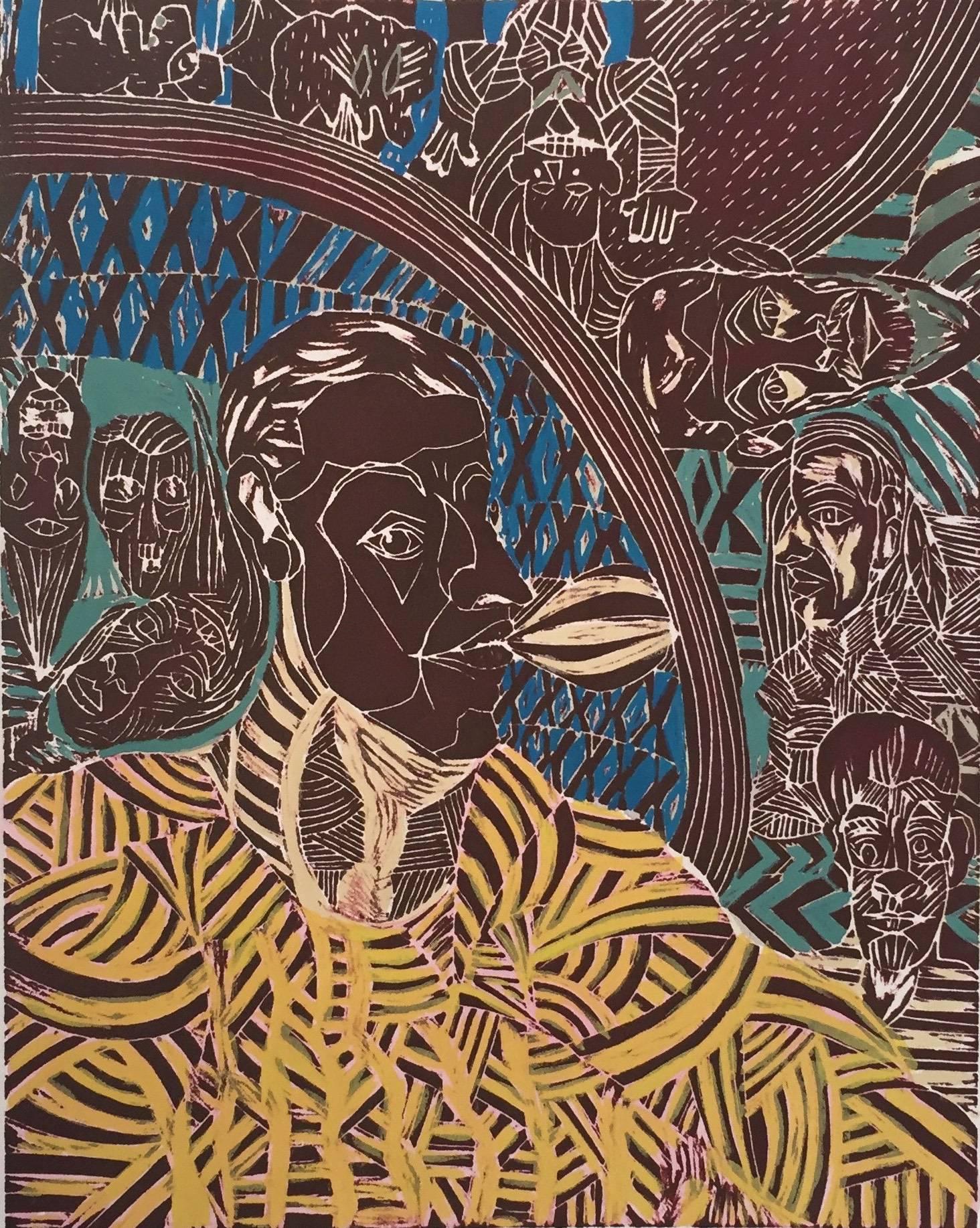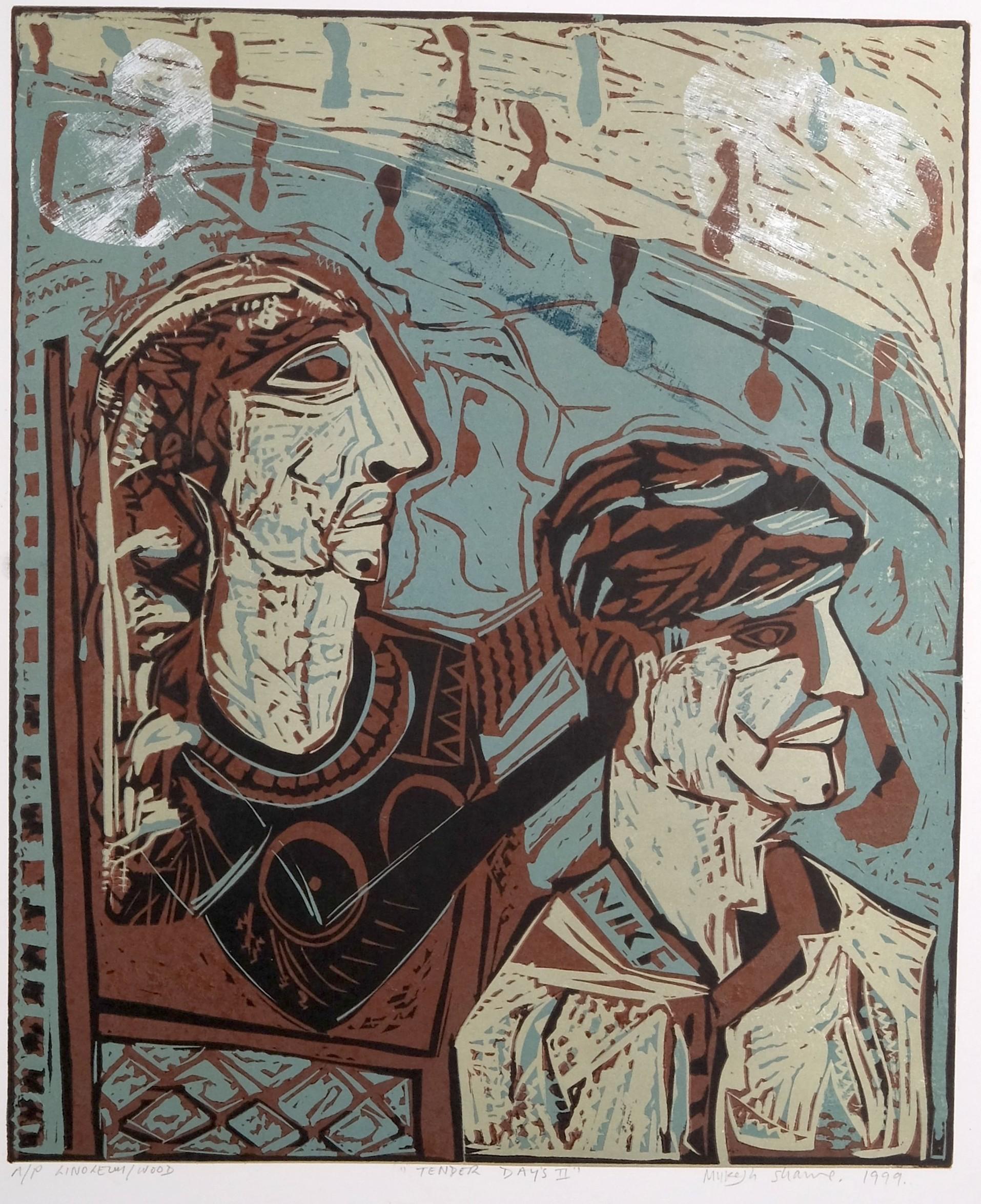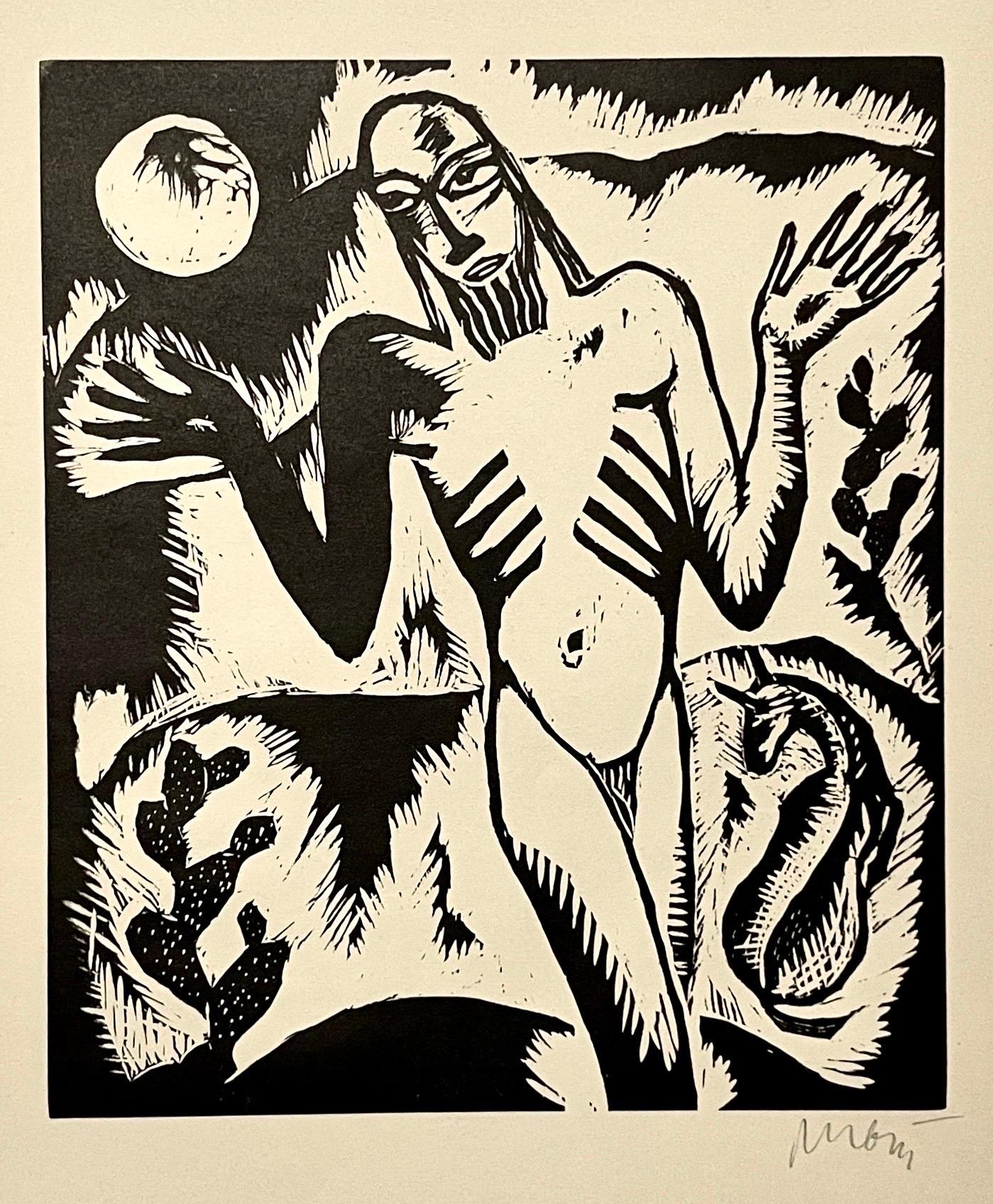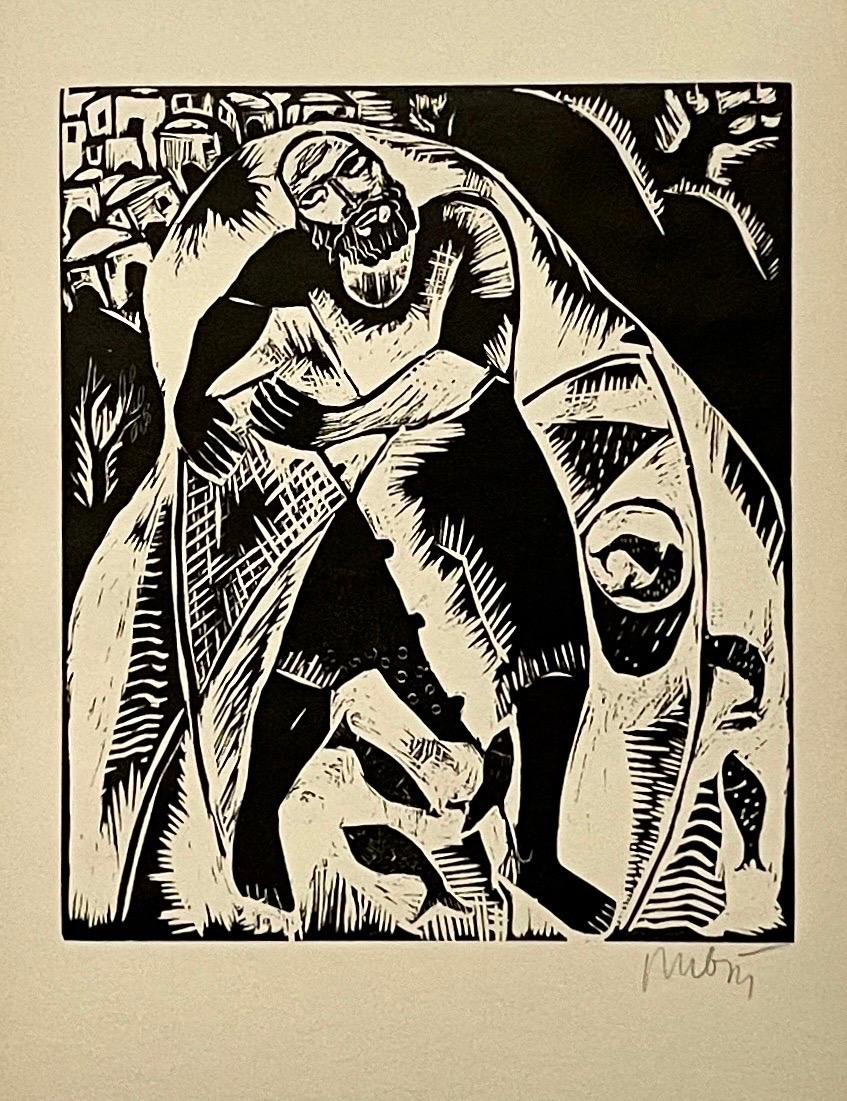Items Similar to Untitled - Woodcut by Pierre Alechinsky - 1970
Want more images or videos?
Request additional images or videos from the seller
1 of 6
Pierre AlechinskyUntitled - Woodcut by Pierre Alechinsky - 19701970
1970
About the Item
Untitled is an Woodcut print realized by Pierre Alechinsky in 1970.
Hand signed on the right margin and numbered on the left corner es. 102/300
The artwork is depicted through strong strokes in a well-balanced composition.
Good conditions.
Pierre Alechinsky (1927) is a Belgian Contemporary Artist . In 1945, Alechinsky discovered the work of Michaux, Dubuffet, surrealists and became friend with the art critic Jacques Putman. His first personal exhibition is organized in 1947. He met Dotremont in 1949 and adhered to the movement CoBrA this same year (Asger Jorn, Karel Appel); he was one of the most active members until the CoBrA's dissolution in 1951. Alechinsky participated in the first International Exhibition of CoBrA at the Stedjelijk Museum in Amsterdam. In the 50’s the artist stayed in The Far East, then in The United States; he was interested in the Japanese calligraphy and in the Action Painting. In 1983, Alechinsky becomes a painting teacher in Paris at the Ecole Supérieure des Beaux Arts de Paris. Since The 80’s , the artist goes on his graphic art on a big variety of supports. Exhibition and International retrospectives celebrate him, all over the world museums and galleries welcome his work.
- Creator:Pierre Alechinsky (1927, Belgian)
- Creation Year:1970
- Dimensions:Height: 25.99 in (66 cm)Width: 19.69 in (50 cm)Depth: 0.04 in (1 mm)
- Medium:
- Movement & Style:
- Period:
- Condition:Insurance may be requested by customers as additional service, contact us for more information.
- Gallery Location:Roma, IT
- Reference Number:
Pierre Alechinsky
Pierre Alechinsky is a belgian painter born in 1927 in Brussels. Attracted by painting, Pierre Alechinsky begins aged 17 in the Ecole Nationale Supérieure d'Architecture et des Arts Décoratifs de la Cambre in Brussels. He was involved in the Cobra artistic movement with Karel Appel and Asger Jorn and organised exhibitions. In the early fifties, he learnt the art of engraving with Stanley William Hayter and also Japanese calligraphy. He met Giacometti, Bram Van Velde, and Victor Brauner. In 1955, he signs for his first exhibition at the Palais des Beaux-Arts de Bruxelles, then at the Institute of Contemporary Arts of London. His artworks, prints, lithographies, engravings and books illustrations can also be found in the USA, in France, in the Netherlands, Denmark and Germany. On and after 1965, fascinated by the Oriental calligraphy, he uses acrylic painting, ink, different types of paper as bills, and gets carried away by action painting technique. During the eighties, he became for four years a teacher of plastic arts at the Ecole Nationale Supérieure des Beaux Arts. Also a writer, Pierre Alechinsky published many books including «Titres et pains perdus », « Baluchon et ricochets », and in 2004 «Des deux mains ». He lives and works in France.
About the Seller
4.9
Platinum Seller
These expertly vetted sellers are 1stDibs' most experienced sellers and are rated highest by our customers.
1stDibs seller since 2017
6,767 sales on 1stDibs
Typical response time: 2 hours
- ShippingRetrieving quote...Ships From: Monaco, Monaco
- Return PolicyA return for this item may be initiated within 14 days of delivery.
More From This SellerView All
- Ex Libris - Mantero - Woodcut by Michel Fingesten - 1930sBy Michel FingestenLocated in Roma, ITEx Libris - Mantero is a Woodcut print created by Michel Fingesten. Hand Signed on the lower right margin. Very Good condition. Michel Fingesten (1884 - 1943) was a Czech painter...Category
1930s Symbolist Figurative Prints
MaterialsWoodcut
- Ex Libris - Robert Malz - Woodcut by Michel Fingesten - 1930sBy Michel FingestenLocated in Roma, ITEx Libris - Robert Malz is a colored Woodcut print created by Michel Fingesten. Hand Signed on the lower right margin. Very Good condition.. Michel Fingesten (1884 - 1943) was a ...Category
1930s Symbolist Figurative Prints
MaterialsWoodcut
- Ex Libris - M.R. - Woodcut by Michel Fingesten - 1930sBy Michel FingestenLocated in Roma, ITEx Libris M.R. is a Woodcut print created by Michel Fingesten. Hand Signed on the lower right margin. Very Good condition. Michel Fingesten (1884 - 1943) was a Czech painter and ...Category
1930s Symbolist Figurative Prints
MaterialsWoodcut
- Ex Libris - Nina Tosi - Woodcut by Michel Fingesten - 1930sBy Michel FingestenLocated in Roma, ITEx Libris - Nina Tosi is a woodcut print created by Michel Fingesten. Hand Signed on the lower right margin. Good conditions. Michel Fingesten (1884 - 1943) was a Czech painter a...Category
1930s Symbolist Figurative Prints
MaterialsWoodcut
- Ex Libris - Woodcut by Michel Fingesten - 1930sBy Michel FingestenLocated in Roma, ITEx Libris is a colored woodcut print created by Michel Fingesten. Hand Signed on the upper margin. Good conditions. Michel Fingesten (1884 - 1943) was a Czech painter and engrav...Category
1930s Symbolist Figurative Prints
MaterialsWoodcut
- Ex Libris - Arnaldo Pescatore - Woodcut by Michel Fingesten - 1930sBy Michel FingestenLocated in Roma, ITEx Libris Arnaldo Pescatore- is a woodcut print created by Michel Fingesten. Hand Signed on the lower right margin. Good conditions. Michel Fingesten (1884 - 1943) was a Czech...Category
1930s Symbolist Figurative Prints
MaterialsWoodcut
You May Also Like
- The Painter Speaks Abstract Expressionist PrintBy Alex LazardLocated in Queretaro, QueretaroTitle: The Painter Speaks Watercolored four-color print on hand-made 100% cotton paper, engraved wood by Alex Lazard. Signed, titled and numbered in pencil. In excellent condition....Category
21st Century and Contemporary Abstract Figurative Prints
MaterialsWatercolor, Woodcut
- Figurative Couple India Ltd Ed A/P Linocut Print Tender Days II Turquoise BrownBy Mukesh SharmaLocated in Norfolk, GBThere is a natural and raw understanding in Mukesh Sharma’s prints that depict, and are influenced by, the Rajastani communities of his home town in rura...Category
1990s Abstract Figurative Prints
MaterialsWoodcut, Archival Ink, Printer's Ink, Archival Paper, Archival Pigment
- IsolationBy Blair Hughes-StantonLocated in Myrtle Beach, SCBlair Hughes-Stanton, 'Isolation', color wood engraving, 1959, edition 15. Signed, titled, dated and numbered '6/15' in pencil. Superb, richly-inked impressions, with fresh, vibrant colors, on heavy, cream, wove, Japan paper; the full sheet with wide margins (2 to 9 1/8 inches). Minor toning at the sheet edges, well away from the images, otherwise in excellent condition. Created as book illustrations, the images are positioned on the sheet accordingly; each image 3 3/4 x 6 1/4 inches; sheet size 16 x 20 inches. Matted to museum standards, unframed. Scarce. ABOUT THE ARTIST Blair Hughes-Stanton (1902-1981) was the only son of a successful landscape painter, Sir Herbert Hughes-Stanton. He had little formal education, joining a cadet school ship at the age of 13. As an artist, he trained at the Byam Shaw School, where he was greatly influenced by Leon Underwood. In 1921, he moved to Underwood’s new school in Hammersmith and when Underwood went to America in 1925, Hughes-Stanton was left in charge of the school. Although he continued to paint and draw, he soon gained a reputation for his wood-engravings. His first published works were illustrations to T.E. Lawrence’s 'The Seven Pillar’s of Wisdom...Category
1950s Abstract Figurative Prints
MaterialsWoodcut
- Rare 1923 Cubist Reuven Rubin Woodcut Woodblock Kabbalah Print Israeli JudaicaBy Reuven RubinLocated in Surfside, FLThis is from the original first edition 1923 printing. there was a much later edition done after these originals. These are individually hand signed in pencil by artist as issued. This listing is for the one print. the other documentation is included here for provenance and is not included in this listing. The various images inspired by the Jewish Mysticism and rabbis and mystics of jerusalem and Kabbalah is holy, dramatic and optimistic Rubin succeeded to evoke the spirit of life in Israel in those early days. They are done in a modern art style influenced by German Expressionism, particularly, Ernst Barlach, Ernst Ludwig Kirchner, and Franz Marc, as introduced to Israel by Jakob Steinhardt, Hermann Struck and Joseph Budko. Reuven Rubin 1893 -1974 was a Romanian-born Israeli painter and Israel's first ambassador to Romania. Rubin Zelicovich (later Reuven Rubin) was born in Galati to a poor Romanian Jewish Hasidic family. He was the eighth of 13 children. In 1912, he left for Ottoman-ruled Palestine to study art at Bezalel Academy of Art and Design in Jerusalem. Finding himself at odds with the artistic views of the Academy's teachers, he left for Paris, France, in 1913 to pursue his studies at the École Nationale Supérieure des Beaux-Arts. He was of the well known Jewish artists in Paris along with Marc Chagall and Chaim Soutine, At the outbreak of World War I, he was returned to Romania, where he spent the war years. In 1921, he traveled to the United States with his friend and fellow artist, Arthur Kolnik. In New York City, the two met artist Alfred Stieglitz, who was instrumental in organizing their first American show at the Anderson Gallery. Following the exhibition, in 1922, they both returned to Europe. In 1923, Rubin emigrated to Mandate Palestine. Rubin met his wife, Esther, in 1928, aboard a passenger ship to Palestine on his return from a show in New York. She was a Bronx girl who had won a trip to Palestine in a Young Judaea competition. He died in 1974. Part of the early generation of artists in Israel, Joseph Zaritsky, Arieh Lubin, Reuven Rubin, Sionah Tagger, Pinchas Litvinovsky, Mordecai Ardon, Yitzhak Katz, and Baruch Agadati; These painters depicted the country’s landscapes in the 1920s rebelled against the Bezalel school of Boris Schatz. They sought current styles in Europe that would help portray their own country’s landscape, in keeping with the spirit of the time. Rubin’s Cezannesque landscapes from the 1920s were defined by both a modern and a naive style, portraying the landscape and inhabitants of Israel in a sensitive fashion. His landscape paintings in particular paid special detail to a spiritual, translucent light. His early work bore the influences of Futurism, Vorticism, Cubism and Surrealism. In Palestine, he became one of the founders of the new Eretz-Yisrael style. Recurring themes in his work were the bible, the prophet, the biblical landscape, folklore and folk art, people, including Yemenite, Hasidic Jews and Arabs. Many of his paintings are sun-bathed depictions of Jerusalem and the Galilee. Rubin might have been influenced by the work of Henri Rousseau whose naice style combined with Eastern nuances, as well as with the neo-Byzantine art to which Rubin had been exposed in his native Romania. In accordance with his integrative style, he signed his works with his first name in Hebrew and his surname in Roman letters. In 1924, he was the first artist to hold a solo exhibition at the Tower of David, in Jerusalem (later exhibited in Tel Aviv at Gymnasia Herzliya). That year he was elected chairman of the Association of Painters and Sculptors of Palestine. From the 1930s onwards, Rubin designed backdrops for Habima Theater, the Ohel Theater and other theaters. His biography, published in 1969, is titled My Life - My Art. He died in Tel Aviv in October 1974, after having bequeathed his home on 14 Bialik Street and a core collection of his paintings to the city of Tel Aviv. The Rubin Museum opened in 1983. The director and curator of the museum is his daughter-in-law, Carmela Rubin. Rubin's paintings are now increasingly sought after. At a Sotheby's auction in New York in 2007, his work accounted for six of the ten top lots. Along with Yaacov Agam and Menashe Kadishman he is among Israel's best known artists internationally. Education 1912 Bezalel Academy of Arts and Design, Jerusalem 1913-14 École des Beaux Arts, Paris and Académie Colarossi, Paris Select Group Exhibitions Eged - Palestine Painters Group Eged - Palestine Painters Group, Allenby Street, Tel Aviv 1929 Artists: Chana Orloff, Abraham Melnikoff, Rubin, Reuven Nahum Gutman, Sionah Tagger,Arieh Allweil, Jewish Artists Association, Levant Fair, Tel Aviv, 1929 Artists: Ludwig Blum,Eliyahu Sigad, Shmuel Ovadyahu, Itzhak Frenel Frenkel,Ozer Shabat, Menahem Shemi...Category
1920s Abstract Figurative Prints
MaterialsWoodcut
- Rare 1923 Cubist Reuven Rubin Woodcut Woodblock Print Israeli Hasidic JudaicaBy Reuven RubinLocated in Surfside, FLThis is from the original first edition 1923 printing. there was a much later edition done after these originals. These are individually hand signed in pencil by artist as issued. This listing is for the one print. the other documentation is included here for provenance and is not included in this listing. The various images inspired by the Jewish Mysticism and rabbis and mystics of jerusalem and Kabbalah is holy, dramatic and optimistic Rubin succeeded to evoke the spirit of life in Israel in those early days. They are done in a modern art style influenced by German Expressionism, particularly, Ernst Barlach, Ernst Ludwig Kirchner, and Franz Marc, as introduced to Israel by Jakob Steinhardt, Hermann Struck and Joseph Budko. Reuven Rubin 1893 -1974 was a Romanian-born Israeli painter and Israel's first ambassador to Romania. Rubin Zelicovich (later Reuven Rubin) was born in Galati to a poor Romanian Jewish Hasidic family. He was the eighth of 13 children. In 1912, he left for Ottoman-ruled Palestine to study art at Bezalel Academy of Art and Design in Jerusalem. Finding himself at odds with the artistic views of the Academy's teachers, he left for Paris, France, in 1913 to pursue his studies at the École Nationale Supérieure des Beaux-Arts. He was of the well known Jewish artists in Paris along with Marc Chagall and Chaim Soutine, At the outbreak of World War I, he was returned to Romania, where he spent the war years. In 1921, he traveled to the United States with his friend and fellow artist, Arthur Kolnik. In New York City, the two met artist Alfred Stieglitz, who was instrumental in organizing their first American show at the Anderson Gallery. Following the exhibition, in 1922, they both returned to Europe. In 1923, Rubin emigrated to Mandate Palestine. Rubin met his wife, Esther, in 1928, aboard a passenger ship to Palestine on his return from a show in New York. She was a Bronx girl who had won a trip to Palestine in a Young Judaea competition. He died in 1974. Part of the early generation of artists in Israel, Joseph Zaritsky, Arieh Lubin, Reuven Rubin, Sionah Tagger, Pinchas Litvinovsky, Mordecai Ardon, Yitzhak Katz, and Baruch Agadati; These painters depicted the country’s landscapes in the 1920s rebelled against the Bezalel school of Boris Schatz. They sought current styles in Europe that would help portray their own country’s landscape, in keeping with the spirit of the time. Rubin’s Cezannesque landscapes from the 1920s were defined by both a modern and a naive style, portraying the landscape and inhabitants of Israel in a sensitive fashion. His landscape paintings in particular paid special detail to a spiritual, translucent light. His early work bore the influences of Futurism, Vorticism, Cubism and Surrealism. In Palestine, he became one of the founders of the new Eretz-Yisrael style. Recurring themes in his work were the bible, the prophet, the biblical landscape, folklore and folk art, people, including Yemenite, Hasidic Jews and Arabs. Many of his paintings are sun-bathed depictions of Jerusalem and the Galilee. Rubin might have been influenced by the work of Henri Rousseau whose naice style combined with Eastern nuances, as well as with the neo-Byzantine art to which Rubin had been exposed in his native Romania. In accordance with his integrative style, he signed his works with his first name in Hebrew and his surname in Roman letters. In 1924, he was the first artist to hold a solo exhibition at the Tower of David, in Jerusalem (later exhibited in Tel Aviv at Gymnasia Herzliya). That year he was elected chairman of the Association of Painters and Sculptors of Palestine. From the 1930s onwards, Rubin designed backdrops for Habima Theater, the Ohel Theater and other theaters. His biography, published in 1969, is titled My Life - My Art. He died in Tel Aviv in October 1974, after having bequeathed his home on 14 Bialik Street and a core collection of his paintings to the city of Tel Aviv. The Rubin Museum opened in 1983. The director and curator of the museum is his daughter-in-law, Carmela Rubin. Rubin's paintings are now increasingly sought after. At a Sotheby's auction in New York in 2007, his work accounted for six of the ten top lots. Along with Yaacov Agam and Menashe Kadishman he is among Israel's best known artists internationally. Education 1912 Bezalel Academy of Arts and Design, Jerusalem 1913-14 École des Beaux Arts, Paris and Académie Colarossi, Paris Select Group Exhibitions Eged - Palestine Painters Group Eged - Palestine Painters Group, Allenby Street, Tel Aviv 1929 Artists: Chana Orloff, Abraham Melnikoff, Rubin, Reuven Nahum Gutman, Sionah Tagger,Arieh Allweil, Jewish Artists Association, Levant Fair, Tel Aviv, 1929 Artists: Ludwig Blum,Eliyahu Sigad, Shmuel Ovadyahu, Itzhak Frenel Frenkel,Ozer Shabat, Menahem Shemi...Category
1920s Abstract Figurative Prints
MaterialsWoodcut
- Rare 1923 Cubist Reuven Rubin Woodcut Woodblock Fisherman Print Israeli JudaicaBy Reuven RubinLocated in Surfside, FLThis is from the original first edition 1923 printing. there was a much later edition done after these originals. These are individually hand signed in pencil by artist as issued. This listing is for the one print. the other documentation is included here for provenance and is not included in this listing. The various images inspired by the Jewish Mysticism and rabbis and mystics of jerusalem and Kabbalah is holy, dramatic and optimistic Rubin succeeded to evoke the spirit of life in Israel in those early days. They are done in a modern art style influenced by German Expressionism, particularly, Ernst Barlach, Ernst Ludwig Kirchner, and Franz Marc, as introduced to Israel by Jakob Steinhardt, Hermann Struck and Joseph Budko. Reuven Rubin 1893 -1974 was a Romanian-born Israeli painter and Israel's first ambassador to Romania. Rubin Zelicovich (later Reuven Rubin) was born in Galati to a poor Romanian Jewish Hasidic family. He was the eighth of 13 children. In 1912, he left for Ottoman-ruled Palestine to study art at Bezalel Academy of Art and Design in Jerusalem. Finding himself at odds with the artistic views of the Academy's teachers, he left for Paris, France, in 1913 to pursue his studies at the École Nationale Supérieure des Beaux-Arts. He was of the well known Jewish artists in Paris along with Marc Chagall and Chaim Soutine, At the outbreak of World War I, he was returned to Romania, where he spent the war years. In 1921, he traveled to the United States with his friend and fellow artist, Arthur Kolnik. In New York City, the two met artist Alfred Stieglitz, who was instrumental in organizing their first American show at the Anderson Gallery. Following the exhibition, in 1922, they both returned to Europe. In 1923, Rubin emigrated to Mandate Palestine. Rubin met his wife, Esther, in 1928, aboard a passenger ship to Palestine on his return from a show in New York. She was a Bronx girl who had won a trip to Palestine in a Young Judaea competition. He died in 1974. Part of the early generation of artists in Israel, Joseph Zaritsky, Arieh Lubin, Reuven Rubin, Sionah Tagger, Pinchas Litvinovsky, Mordecai Ardon, Yitzhak Katz, and Baruch Agadati; These painters depicted the country’s landscapes in the 1920s rebelled against the Bezalel school of Boris Schatz. They sought current styles in Europe that would help portray their own country’s landscape, in keeping with the spirit of the time. Rubin’s Cezannesque landscapes from the 1920s were defined by both a modern and a naive style, portraying the landscape and inhabitants of Israel in a sensitive fashion. His landscape paintings in particular paid special detail to a spiritual, translucent light. His early work bore the influences of Futurism, Vorticism, Cubism and Surrealism. In Palestine, he became one of the founders of the new Eretz-Yisrael style. Recurring themes in his work were the bible, the prophet, the biblical landscape, folklore and folk art, people, including Yemenite, Hasidic Jews and Arabs. Many of his paintings are sun-bathed depictions of Jerusalem and the Galilee. Rubin might have been influenced by the work of Henri Rousseau whose naice style combined with Eastern nuances, as well as with the neo-Byzantine art to which Rubin had been exposed in his native Romania. In accordance with his integrative style, he signed his works with his first name in Hebrew and his surname in Roman letters. In 1924, he was the first artist to hold a solo exhibition at the Tower of David, in Jerusalem (later exhibited in Tel Aviv at Gymnasia Herzliya). That year he was elected chairman of the Association of Painters and Sculptors of Palestine. From the 1930s onwards, Rubin designed backdrops for Habima Theater, the Ohel Theater and other theaters. His biography, published in 1969, is titled My Life - My Art. He died in Tel Aviv in October 1974, after having bequeathed his home on 14 Bialik Street and a core collection of his paintings to the city of Tel Aviv. The Rubin Museum opened in 1983. The director and curator of the museum is his daughter-in-law, Carmela Rubin. Rubin's paintings are now increasingly sought after. At a Sotheby's auction in New York in 2007, his work accounted for six of the ten top lots. Along with Yaacov Agam and Menashe Kadishman he is among Israel's best known artists internationally. Education 1912 Bezalel Academy of Arts and Design, Jerusalem 1913-14 École des Beaux Arts, Paris and Académie Colarossi, Paris Select Group Exhibitions Eged - Palestine Painters Group Eged - Palestine Painters Group, Allenby Street, Tel Aviv 1929 Artists: Chana Orloff, Abraham Melnikoff, Rubin, Reuven Nahum Gutman, Sionah Tagger,Arieh Allweil, Jewish Artists Association, Levant Fair, Tel Aviv, 1929 Artists: Ludwig Blum,Eliyahu Sigad, Shmuel Ovadyahu, Itzhak Frenel Frenkel,Ozer Shabat, Menahem Shemi, First Exhibition of ''Hever Omanim'' First Exhibition of ''Hever Omanim'' Steimatzky Gallery, Jerusalem 1936 Artists: Gutman, Nachum Holzman, Shimshon Mokady, Moshe Sima, Miron Rubin, Reuven Steinhardt, Jakob Ben Zvi, Zeev Ziffer, Moshe Allweil, Arieh Group Exhibition Group Exhibition Katz Art Gallery, Tel Aviv 1939 Artists: Avni, Aharon Holzman, Shimshon Gliksberg, Haim Gutman, Nachum Ovadyahu, Shmuel Shorr, Zvi Schwartz, Chaya Streichman, Yehezkel Tagger, Sionah Rubin, Reuven A Collection of Works by Artists of the Land of Israel A Collection of Works by Artists of the Land of Israel The Bezalel National Museum, Jerusalem 1940 Artists: Shemi, Menahem Rubin, Reuven Avni, Aharon Mokady, Moshe Jonas, Ludwig Steinhardt, Jakob Ticho, Anna Krakauer, Leopold Gutman, Nachum Budko, Joseph Ardon, Mordecai Sima, Miron Castel, Moshe Pann, Abel Struck, Hermann Gur Arie, Meir Ben Zvi, Zeev Litvinovsky, Pinchas Artists in Israel for the Defense, Tel Aviv Museum of Art, Helena Rubinstein Pavilion, Tel Aviv 1967 Artists: Avraham Binder, Motke Blum, (Mordechai) Samuel Bak, Yosl Bergner, Nahum Gilboa, Jean David, Marcel Janco, Lea Nikel, Jacob Pins, Esther Peretz...Category
1920s Abstract Figurative Prints
MaterialsWoodcut






